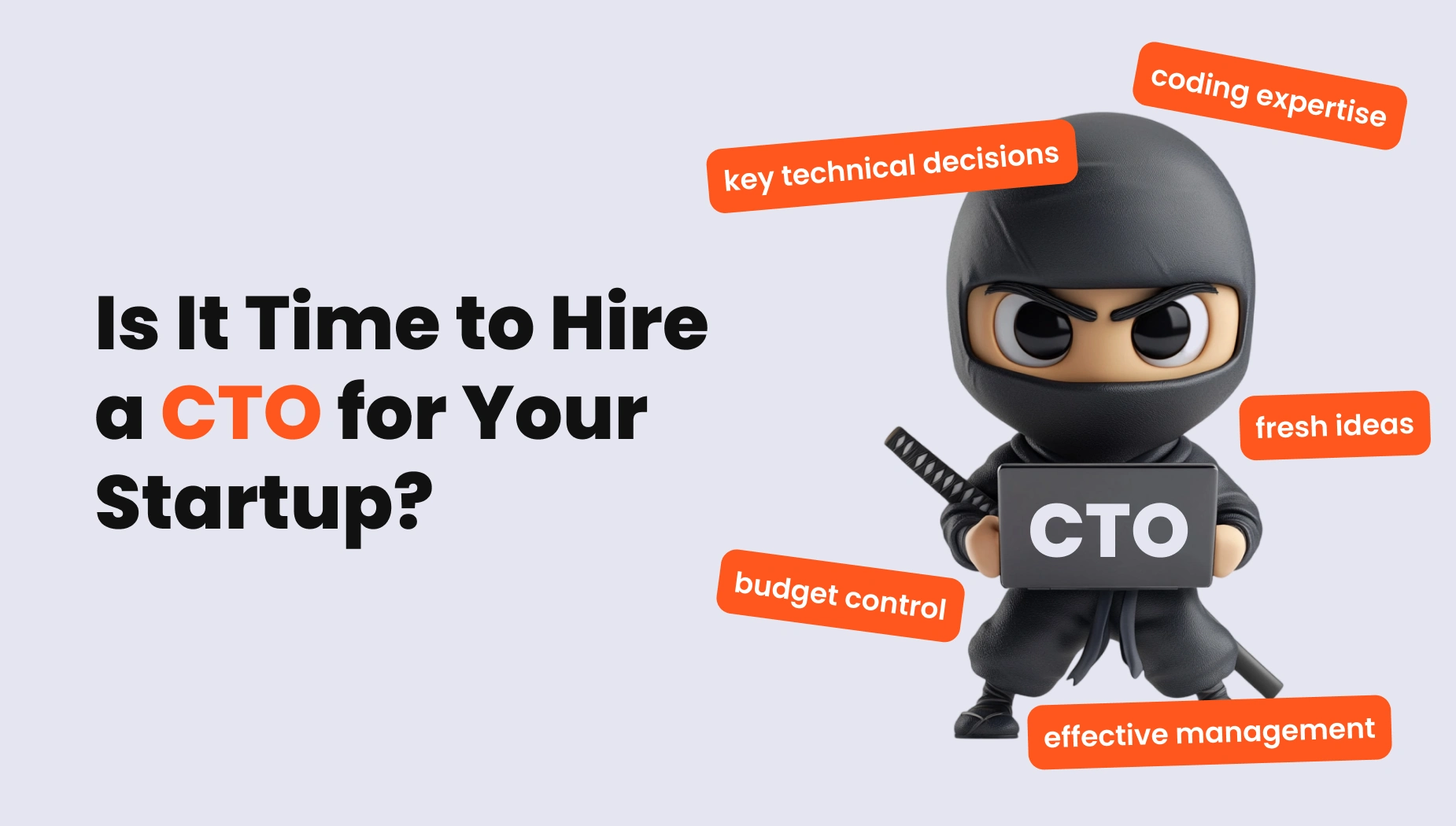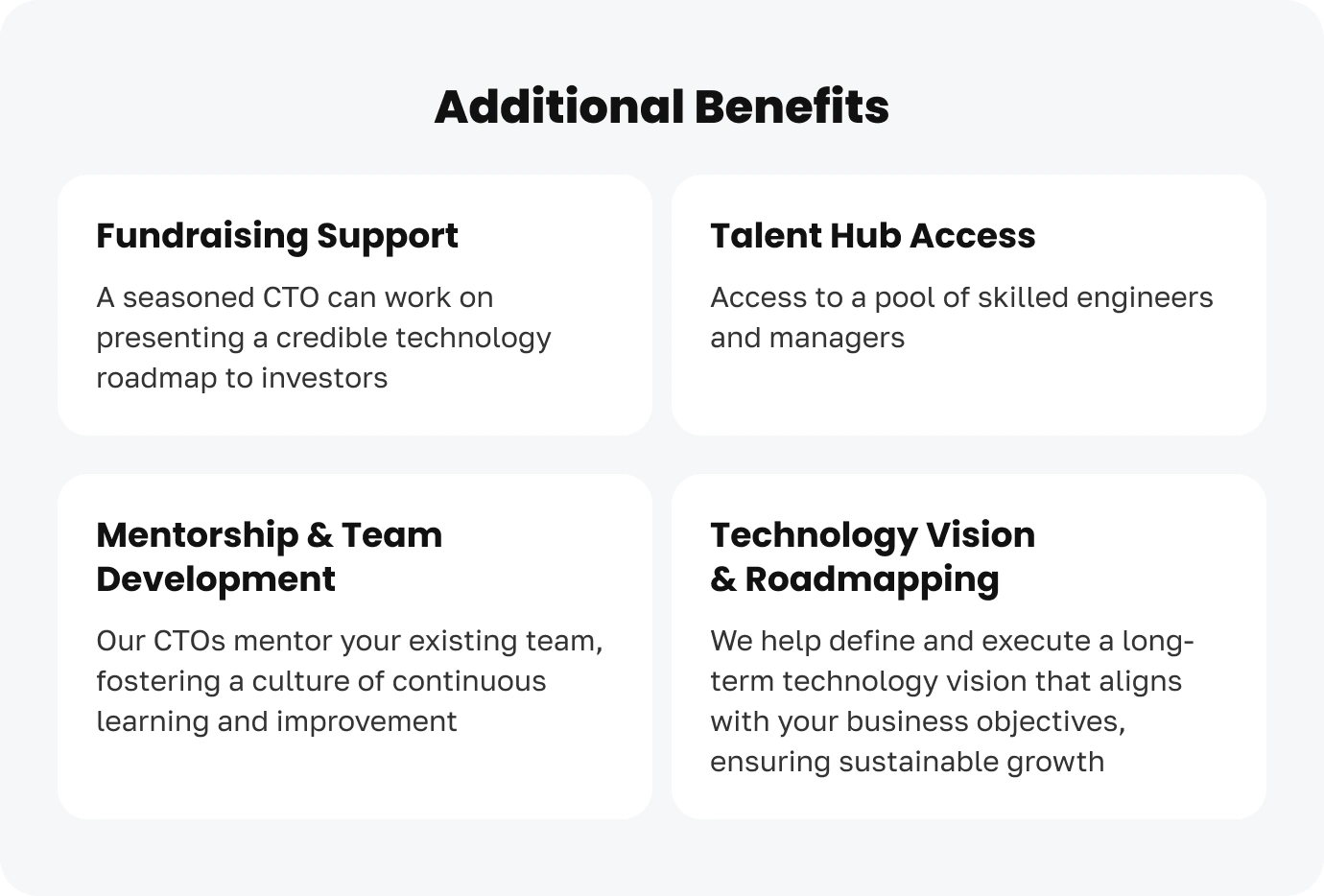Table of Contents
Launching a startup often means juggling multiple roles, and one common challenge founders face is managing the technical aspects of their business.
Let’s say there’s a young founder who starts as an interim CTO of a startup.
Initially, he’s focused on coding and architectural design, but he soon realizes that the CTO role is much broader than just being the “tech guy.” As he grows into the position, he learns that a CTO has to manage security and compliance and align technology with business goals.
It goes far beyond development skills.
And the pressure to quickly gain this extensive experience can be overwhelming.
Next step: The founder brings in an experienced CTO through a service like CTO as a Service (CTOaaS) and gets the leadership needed to steer the company’s tech strategy. This approach allows the founder to focus on his strengths in development.
Let’s now highlight the next steps and find out when a startup should hire its own CTO.
Why Hire a CTO?
Randomly hiring developers or freelancers without technical oversight can lead to costly mistakes.
On the other hand, hiring a seasoned CTO is challenging because the role demands more than just coding expertise. A CTO oversees development, makes key technical decisions, and ensures that technology aligns with the company’s broader vision.
CTO can bring additional value to the project by adding fresh ideas and innovation or sharing valuable connections from the IT network that can benefit the project.
While some founders may believe a CTO’s role is solely to keep projects on track, a skilled CTO assesses the feasibility of plans and identifies the most efficient, cost and risk-effective implementation methods.
A strong CTO avoids inefficiencies, controls the budget, and equips the development team with tools and knowledge for effective management.
CTO experts help prevent developers from spending too much time on tasks or “gold plating” that slow things down and draw the budget. This is especially critical for medium and larger projects, where mismanagement can lead to lost market opportunities.
For larger or more complex projects, having a CTO or a technical co-founder is essential to ensure success and drive the company forward.
Building an Internal CTO: Desirable Yet Demanding
Developing a CTO internally is desirable but is time-consuming and complex due to several challenges.
Comprehensive Skill Development
A successful CTO needs a mix of deep technical expertise, strategic vision, and strong team management skills.
- Technical Skills and Knowledge
- Strategic Vision and Business Acumen
- Leadership and Team Development
- Communication and Stakeholder Management
- Problem-Solving
- Governance and Compliance
- Financial Management and Budgeting
Building such a leader internally is time-consuming and requires ongoing investment in technical skills, strategic planning, and leadership development.
Evolving Demands with Company Scaling
As a company scales, the demands on the CTO evolve significantly. What works at an early startup phase is often very different from what’s required in later stages of growth and maturity.
The CTO’s role shifts from the goal of achieving product-market fit with a short-term vision to a long-term vision and strategy, focusing on long-term planning, sustainability, and aligning technology with the company’s vision.
Resource-Intensive Process
Internally developing a CTO demands substantial resources:
- High costs associated with specialized training and ongoing learning.
- Investment in coaching for leadership development.
- Long hiring processes and specialized talent acquisition requirements.
- Increased costs associated with scaling teams and technologies.
Organizational Resistance
Developing a Chief Technology Officer (CTO) internally is challenging due to organizational resistance. Company culture and employees may hesitate to embrace new leadership or technological changes.
This resistance can appear as reluctance to adopt new processes, skepticism about the CTO’s vision, or fear of shifting power dynamics.
Overcoming these barriers requires effective change management, including clear communication, stakeholder involvement, and fostering a culture of adaptability and continuous improvement.
Retention and Succession Planning
Successfully retaining talent and preparing future leaders require organizations to actively engage employees and develop their leadership potential.
- Employee Engagement: Creating meaningful work and career growth opportunities to retain talent.
- Identifying High-Potential Talent: Recognizing and preparing future leaders through targeted development.
- Mentorship Programs: Facilitating knowledge transfer and leadership development through mentorship.
- Continuous Evaluation: Regularly reassessing succession plans and employee performance.
Retaining high-potential employees is essential, as competitors frequently target them for future CTO roles. Organizations must offer clear career paths, competitive salaries, and a supportive work environment to keep these talents engaged.
If your organization isn’t ready for this investment, CTOaaS offers an effective alternative by providing immediate access to experienced technical leaders who can guide your tech strategy from day one.
CTOaaS professionals bring hands-on strategies, connections, and shortcuts proven by successful projects. This helps your startup grow faster without delays from building internal talent.
Why JetRuby?
At JetRuby, we excel in talent management, refined over 14 years. Our team of over 100 Ruby on Rails developers, trained through our Ruby on Rails Academy, can scale client teams swiftly —often within 10 business days.
Our ISO 30414 and ISO 10018 certifications demonstrate our commitment to people management. They ensure our team members are 35% more efficient than industry peers. This efficiency allows clients to save time and resources while receiving high-quality outcomes.
We leverage AI-supported development to automate routine tasks for faster and more reliable results. Our proprietary tool, ITD.HUB, provides real-time transparency, which allows our clients to monitor project progress and maintain control throughout development.
As part of our audit and implementation process, we focus on four critical areas:
Product management
We assess how product managers communicate requirements to development teams, ensuring seamless translation of product goals into actionable tasks.
Delivery processes
We evaluate the effectiveness of development methodologies, task estimation, planning, deadline adherence, release quality, and project portfolio management, including rapid development strategies and Proof of Concept (PoC) testing for product hypotheses.
Talent management
We analyze recruitment methodologies, strategies for employee development and engagement, tools for motivation and retention, and their alignment with company goals.
Technology & infrastructure
We examine your current technology stack and infrastructure to ensure tools and systems are optimized for efficiency and scalability.
The Benefits of JetRuby’s CTOaaS
JetRuby’s CTO as a Service (CTOaaS) helps companies efficiently build or strengthen IT teams, enhancing agility and performance. Our services offer immediate, expert-led support for creating tech teams, boosting existing departments, and maintaining cost-effective, transparent operations through tools like ITD.HUB. CTOaaS provides the resources and insight needed to achieve business goals without compromising control over strategic direction.
Building IT departments from scratch
We help build IT departments from the ground up. Backed by our expertise in managing squads of over 300 engineers, we create and develop effective tech teams that deliver results.
Strengthening existing teams
If your IT department is overwhelmed by workload or quality issues, we offer additional expertise, resources, and technologies to boost performance and streamline processes.
Time and cost efficiency
CTOaaS offers immediate access to a wealth of expertise without the lengthy and expensive process of hiring a high-level CTO. You quickly adapt to market changes and stay competitive.
Complete transparency with ITD.HUB
Our proprietary tool, ITD.HUB, offers full visibility into your development processes, allowing you to monitor and control your team’s work in real time.
Avoiding vendor lock-in
With CTOaaS, you maintain full control over your project and strategic decisions. We only provide the tools, technology, and expertise you need to meet your goals, and you retain authority over your company’s direction.
A Strategic Solution for Immediate Leadership
JetRuby’s CTO as a Service provides a strategic and streamlined solution for companies looking to avoid the challenges of developing a CTO internally.
By engaging a seasoned CTO through our model, you gain instant access to expert leadership capable of optimizing your technology strategies and driving sustainable growth.
No delays and uncertainties in nurturing talent from within.
Whether you need to build an IT department from scratch, strengthen an existing team, or streamline your operations, JetRuby’s CTOaaS provides the experience and resources necessary to help your company thrive.





